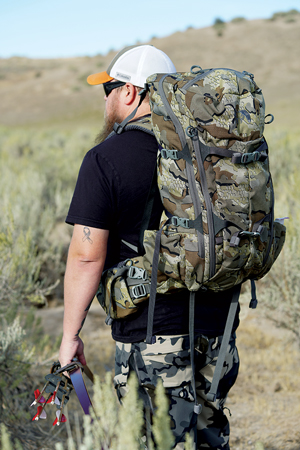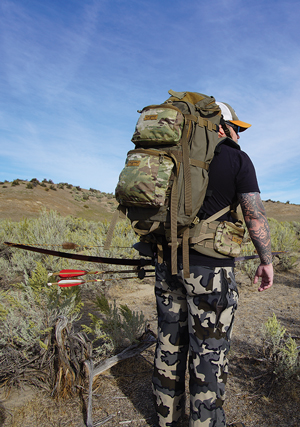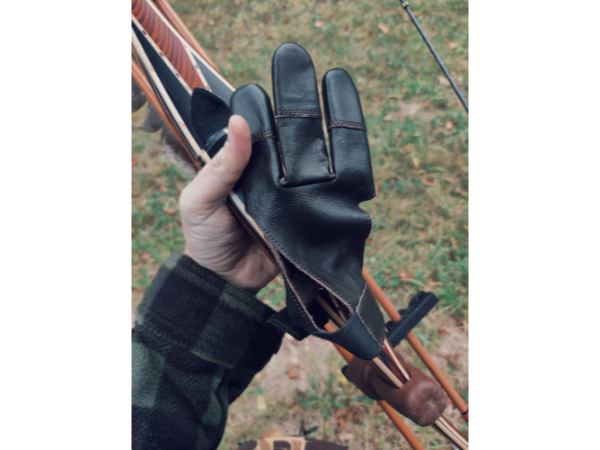I vividly remember the first time I prepared for a mule deer hunt with my dad. In fact, I remember it better than the actual hunt. It was August 1996, and I had just finished my Hunters Education course. The excitement of getting to go hunting was likely the only thing that made those awkward transition years from elementary school to junior high bearable. Almost every day after school, I would go to some friends’ house so they could show off their new hunting gear.
I remember it so vividly because they had so much cool stuff, and I simply did not. Surprisingly, I never really cared much about all the cool camo they had. I was more drawn to the packs. Most of them were from Kelty, because they used them more for backpacking trips in the summer than for hunting trips in the fall. I thought they were just the coolest packs in the world. They seemed to have infinite pockets and pouches to store…well, whatever it is you need to store while hunting. I had absolutely no idea what I’d put in them, but I knew I wanted them all the same. The packs had straps for what I could only assume at the time was adjusting…something.
When I got home, I’d avoid looking at my hand-me-down pack, which was nothing more than an aluminum rectangular frame with a faded green bag strapped to it. It wasn’t flashy, it had no pockets, and worst of all to a budding 7th grade hunter…it was functional—something I obviously could not care less about at the time.
Now I’m 24 years older and at least five years wiser, and I still have a thing for flashy packs. However, now having had experience hauling elk quarters up a mountain with a pack that is not designed for such chores, I have a much greater appreciation for packs designed specifically for hunting.
Over the past 20 years, pack technology has improved exponentially. There are now so many manufacturers that make excellent packs that it’s really hard to choose one. I spent hours researching different manufacturers and packs. I read seemingly endless social media posts asking what is best and was only able to come to the conclusion that there is no “best.” Every hunter is different, and every style is unique. Many of my hunting buddies live in the Midwest, where they are able to hunt whitetails from tree stands after work. I live in Idaho, where I need to drive for a couple of hours and pack in at least one more to get away from the crowds. What works for them most likely wouldn’t work for me, so I began to research manufacturers. My search ended with two brands, each with a solid following, and each with people I know who have used them. Thus began the Battle of the K’s: KUIU vs. Kifaru
KUIU Pro 3600
I started with KUIU because I wear their camo, so a pack that matches made sense. What I found was a solid, ready-to-go, straight from the manufacturer pack. Their packs come in all the same camo patterns they offer in their clothing (Verde, Vias, and the new Valo), as well as either a solid grey they call phantom, or a combination of ash and phantom. If you’re a fan of KUIU patterns, then aesthetically you’ll like the packs as well.
Their frame pack kits come in two different styles—the Pro LT, which is their lightweight series, and the Pro series. The LT ranges from 4000 cubic inches, to 7000, whereas the Pro series ranges from 1850 cubic inches to 7800.

The KUIU Pro 3600 is rated up to 150#, has several unique features, and is quite comfortable.
I tested a Pro 3600 with the Pro suspension, in the new Valo pattern. The bag is made from 500D CORDURA® Ripstop fabric and has water repellant treatment in it as well. The frame and suspension are compatible with any Pro series bag, including the LT series, so if I decide I want a larger pack for a long day hunt out of a backpack, I only need to buy the bag, and not a whole new kit. Two side zippered pockets are sewn into the bag, along with two side stuff pockets. There is one pocket on the top and six internal pockets as well, and the pack opens with a full horseshoe zip front making it easy to pack, unpack, and access.
The buckles and compression straps are well made and come with Velcro strips to roll up the excess strap, so they aren’t flying around everywhere during your hunt. The zippers and buckles seem quiet as well, and the zipper pulls are constructed of paracord and a soft plastic so there’s no metal on metal at all.
According to KUIU, the bag is rated for up to 150 pounds. When I loaded it up with 90# and took it for a walk, the bag seemed to handle the weight fine…better than I did! The bag also can disconnect from the frame at the top. Through the use of compression straps that connect the bottom of the bag to the frame, you can create a meat shelf between the bag and the frame for hauling heavier loads.
The Pro suspension system is surprisingly comfortable. After spending many years at a desk job, my core strength could use some work. The additional lumbar support on the suspension really helped make sure everything fit snugly and in the right spots. I did not tire out as fast as I had with other pack systems I’ve used before.
As for accessories, KUIU offers a couple of belt pouches that you can attach to the structured belt. They also offer a bladder that fits in the hydration pouch in the bag. However, any standard hydration bladder should work fine. The bag does have zippered holes on either side of the bag for the tube to come out of, so that provides options depending on what side of the pack you prefer your hose to come from. KUIU also offers a load hauler in case you want to leave your bag at camp, and just haul your harvest. The hauler attaches directly to the frame and suspension and provides a great option for securing a load to your back. They also have a gun holder and a bow holder that you can attach to your pack, but personally I don’t use those because it’s hard to shoot your bow when it’s strapped to your pack, and the bow holder is geared more toward compounds.
All in all, at around the $500 price point, the KUIU pack seems to be a solid pack for someone who wants a more traditional style pack that is pretty much ready right out of the box to load up and go hunting.
Kifaru 22 Mag
I picked up this pack used, but in like-new condition. It was almost the exact setup I was looking for in a Kifaru bag and has served me extremely well so far. As of late, Kifaru has gained a reputation of being the pack for any hunt and for outdoor enthusiasts looking for a pack that will stand the test of time. Quality like that does come at a cost, and Kifaru pack systems tend to be on the more expensive side.

The Kifaru 22 Mag is a heavier pack, but has lots of options to accommodate many hunter needs.
My Kifaru setup is the 22 Mag bag, on the Duplex lite frame. I specifically wanted the 22 Mag for my bag because it’s a smaller bag—slightly bigger than necessary for a daypack, but it can compress down to a more manageable size. On the other hand, the 22 Mag is big enough to be able to pack out some elk tenderloins and backstrap after a harvest, and with the addition of the frame, full elk quarters are not a problem either. Additionally, it has a built-in meat shelf, so I’m not relying only on compression straps to get that job done.
Kifaru bags are very well constructed. This one is also made with 500D DWR Coated CORDURA®. This material is heavier, and bulkier than some packs, but what you sacrifice in weight, you make up for in durability. I have only used my pack for one season, but the sheer amount of used packs I see circulating the market today suggests these packs can take quite a beating and remain in good condition.
The bag front is covered with PALS webbing, for attaching pouches, accessories, or even other Kifaru bags. The 22 Mag runs 2,200 cubic inches, so is a bit smaller than the KUIU, but the way it’s laid out I feel that I get just as much use out of the room as I do with the larger bag. The webbing on the front of the bag allows me to add other Kifaru bags to it as well, making this model very versatile. I can take this from a smaller bag for a weekend hunt, to a larger extended backpack hunt bag extremely easily.
Attached to my bag, I have one of each of the Kifaru belt pouches, large, medium, and small. These pouches are in addition to the one that is sewn into the bag on the top, which I use for my map, snacks, and headlamp. Finally, I have Kifaru’s Nalgene® pouch attached to my belt. In addition to the Nalgene pouch, most Kifaru bags come with built in bladder pouches should you prefer to use hydration bladders in lieu of a water bottle.
I also have a Guide Lid, which I can attach to my pack in various ways to add another 1,200 cubic inches of volume to my setup. This could be used as a final approach pack, or I can fill it with my camp kit and just drop it at camp and go hunt.
The frame is very well made and set up so that interchanging the different bags that Kifaru makes is very simple. The frame is also made so that you can easily remove the pack and just use the frame to haul a harvest. The belt, which I consider to be one of the most important parts of the frame, is very comfortable, and there are plenty of adjustments that can be made to cinch the bag to the frame so the weight sits on your hips and not your back or shoulders. The lumbar support is also just as comfortable as the KUIU and really helps keep everything in place.
I have had this pack loaded up to 115 pounds inside the bag, and it didn’t seem to stress it much. It’s pretty clear that the bag and frame can probably handle more weight than my own body can. I will likely be taking this pack out for spring bear this year, and am hoping for the opportunity to put it, and myself, through the wringer.
The bag and frame will run around $610 through Kifaru, and the accessories and pouches can run anywhere from $35 each, to over $100 depending on what you are getting. This really does put Kifaru in the next tier from a price point. However, from a quality standpoint, they really do make a pack that can last for many seasons to come.







Leave A Comment